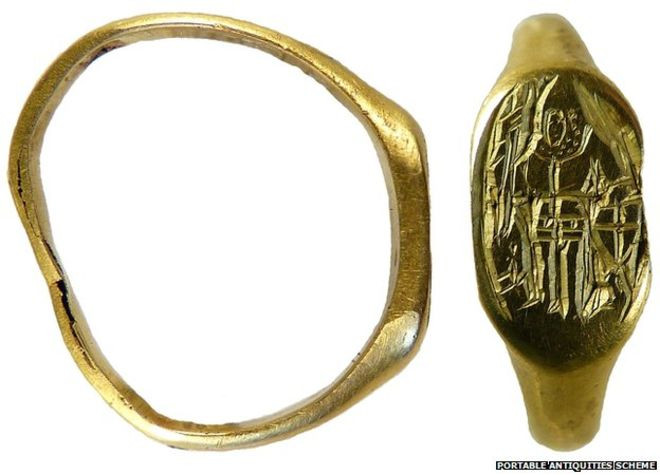600-year-old medieval St George ring found by amateur metal detectorist in Norfolk

One lucky metal detectorist uncovered the ring in South Creake, Norfolk in February which dates back to 14th century.
The 600-year old gold ring engraved with St George and the Dragon brings new insight to the saint's medieval followers in Norwich, an expert has told the BBC.
Coin expert at Norwich Castle Museum, Dr Adrian Marsden, said: "The ring has on it St George spearing a dragon. That is unusual and interesting because St George was a very popular saint in Norwich."
The ring, which dates back to the 14th Century, was found alongside 10 pennies, one half-penny and three farthings from the Edward I era, relics which have attracted the interest of Norwich Castle Museum and the British Museum in London.
How is a treasure classified?
Any object which contains more than 10% silver and gold and is over 300 years old must be reported to the coroner, who will then decide if it is classed as treasure under the Treasure Act of 1996
If museums acquire an object like this, finders are normally rewarded the full market value, determined by experts at the British Museum.
Dr Jonathan Good, associate professor of history at Reinhardt University tells the BBC that the "could have have owned by a guild member. It could have been a way of them showing their dedication".
Kathleen Kennedy, associate professor at Penn State-Brandywine University in the US, and expert in medieval rings says the ring was "originally enameled, so like so much of the medieval statuary remaining to us today, what we see as one colour would have originally been brightly variegated."
Medieval guilds were formed by groups of people who came together and paid a weekly subscription to celebrate a particular saint and pray for dead guild members and provide sickness benefit.
The longest-running was the guild of St George in Norwich which operated between 1385 and 1548. Each member subscribed a farthing a week and held services on St George's feast day on 23 April.
An inquest in Norwich this week declared the ring 'a treasure.'
Other pieces that have also been declared as treasure at the inquest include a post-medieval coin pendant found near Fakenham; a medieval brooch discovered in Grimston, and a late Anglo-Saxon strap end found in North Pickenham.
About St George
St George was a soldier in the retinue of the Emperor Diocletian, who ordered the systematic persecution of Christians which George refused to take part, having been born into a Christian family in the late third century. He tortured and executed in Palestine as a result, and became early Christian martyr.
St George's Day is celebrated on 23 April in England, the same day of George's martyrdom in 303.
Medieval legend says George slayed a dragon to rescue an innocent maiden from death.
Source: BBC History
© Copyright IBTimes 2025. All rights reserved.





















